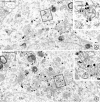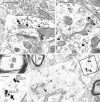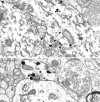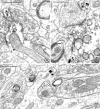Ultrastructural localization of the vesicular monoamine transporter-2 in midbrain dopaminergic neurons: potential sites for somatodendritic storage and release of dopamine
- PMID: 8753875
- PMCID: PMC6579002
- DOI: 10.1523/JNEUROSCI.16-13-04135.1996
Ultrastructural localization of the vesicular monoamine transporter-2 in midbrain dopaminergic neurons: potential sites for somatodendritic storage and release of dopamine
Abstract
Midbrain dopaminergic neurons are known to release dopamine from somata and/or dendrites located in the substantia nigra (SN) and the ventral tegmental area (VTA). There is considerable controversy, however, about the subcellular sites for somatodendritic dopamine storage in these regions. In the present study, we used dual-labeling electron microscopic immunocytochemistry to localize the vesicular monoamine transporter-2 (VMAT2), a novel marker for sites of intracellular monoamine storage, within identified dopaminergic (tyrosine hydroxylase-containing) neurons in the rat SN and VTA. In dopaminergic perikarya, immunogold labeling for VMAT2 was localized to the Golgi apparatus, tubulovesicles that resembled smooth endoplasmic reticulum (SER), and the limiting membranes of multivesicular bodies. In dopaminergic dendrites, VMAT2 was extensively localized to tubulovesicles that resembled saccules of SER, and less frequently localized to isolated small synaptic vesicles (SSVs) or large dense-core vesicles (DCVs). In rare cases, VMAT2-immunoreactive SSVs were clustered within the cytoplasm of an SN or a VTA dendrite. Dopaminergic dendrites in the VTA contained a significantly higher number of immunogold particles for VMAT2 per unit than those in the SN. Together, these observations support the proposal that dopamine is stored in and may be released from dendritic SSVs and DCVs, but suggest that the SER is the major site of dopamine storage within midbrain dopaminergic neurons. In addition, they provide new evidence that dopaminergic dendrites in the VTA may have greater potential for reserpine-sensitive storage and release of dopamine than those in the SN.
Figures






Similar articles
-
Region-specific targeting of dopamine D2-receptors and somatodendritic vesicular monoamine transporter 2 (VMAT2) within ventral tegmental area subdivisions.Synapse. 2002 Aug;45(2):113-24. doi: 10.1002/syn.10092. Synapse. 2002. PMID: 12112404
-
Inverse relationship between the contents of neuromelanin pigment and the vesicular monoamine transporter-2: human midbrain dopamine neurons.J Comp Neurol. 2004 May 17;473(1):97-106. doi: 10.1002/cne.20098. J Comp Neurol. 2004. PMID: 15067721
-
Electron microscopic immunolabeling of transporters and receptors identifies transmitter-specific functional sites envisioned in Cajal's neuron.Prog Brain Res. 2002;136:145-55. doi: 10.1016/s0079-6123(02)36014-x. Prog Brain Res. 2002. PMID: 12143378 Review.
-
The vesicular monoamine transporter 2 is present in small synaptic vesicles and preferentially localizes to large dense core vesicles in rat solitary tract nuclei.Proc Natl Acad Sci U S A. 1995 Sep 12;92(19):8773-7. doi: 10.1073/pnas.92.19.8773. Proc Natl Acad Sci U S A. 1995. PMID: 7568015 Free PMC article.
-
Cholinergic axon terminals in the ventral tegmental area target a subpopulation of neurons expressing low levels of the dopamine transporter.J Comp Neurol. 1999 Jul 26;410(2):197-210. doi: 10.1002/(sici)1096-9861(19990726)410:2<197::aid-cne3>3.0.co;2-d. J Comp Neurol. 1999. PMID: 10414527 Review.
Cited by
-
Somatodendritic dopamine release: recent mechanistic insights.Philos Trans R Soc Lond B Biol Sci. 2015 Jul 5;370(1672):20140185. doi: 10.1098/rstb.2014.0185. Philos Trans R Soc Lond B Biol Sci. 2015. PMID: 26009764 Free PMC article. Review.
-
Electrical and Ca(2+) signaling in dendritic spines of substantia nigra dopaminergic neurons.Elife. 2016 May 10;5:e13905. doi: 10.7554/eLife.13905. Elife. 2016. PMID: 27163179 Free PMC article.
-
A New Glucocerebrosidase Chaperone Reduces α-Synuclein and Glycolipid Levels in iPSC-Derived Dopaminergic Neurons from Patients with Gaucher Disease and Parkinsonism.J Neurosci. 2016 Jul 13;36(28):7441-52. doi: 10.1523/JNEUROSCI.0636-16.2016. J Neurosci. 2016. PMID: 27413154 Free PMC article.
-
Subcellular proteomics of dopamine neurons in the mouse brain.Elife. 2022 Jan 31;11:e70921. doi: 10.7554/eLife.70921. Elife. 2022. PMID: 35098924 Free PMC article.
-
A biochemical and functional protein complex involving dopamine synthesis and transport into synaptic vesicles.J Biol Chem. 2010 Jan 15;285(3):1957-66. doi: 10.1074/jbc.M109.054510. Epub 2009 Nov 10. J Biol Chem. 2010. PMID: 19903816 Free PMC article.
References
-
- Ayala J. Transport and internal organization of membranes: vesicles, membrane networks and GTP-binding proteins. J Cell Sci. 1994;107:753–763. - PubMed
-
- Bannon MJ, Granneman JG, Kapatos G. The dopamine transporter: potential involvement in neuropsychiatric disorders. In: Bloom FE, Kupfer DJ, editors. Psychopharmacology: the fourth generation of progress. Raven; New York: 1995. pp. 179–188.
-
- Bernardini GL, Gu X, Viscardi E, German DC. Amphetamine-induced and spontaneous release of dopamine from A9 and A10 dendrites: an in vitro electrophysiological study in the mouse. J Neural Transm Gen Sect. 1991;84:183–193. - PubMed
-
- Björklund A, Lindvall O. Dopamine in dendrites of substantia nigra neurons: suggestions for a role in dendritic terminals. Brain Res. 1975;83:531–537. - PubMed
-
- Broadwell RD, Cataldo AM. The neuronal endoplasmic reticulum: its cytochemistry and contribution to the endomembrane system. I. Cell bodies and dendrites. J Histochem Cytochem. 1983;31:1077–1088. - PubMed
Publication types
MeSH terms
Substances
Grants and funding
LinkOut - more resources
Full Text Sources
Other Literature Sources
Molecular Biology Databases
Miscellaneous
